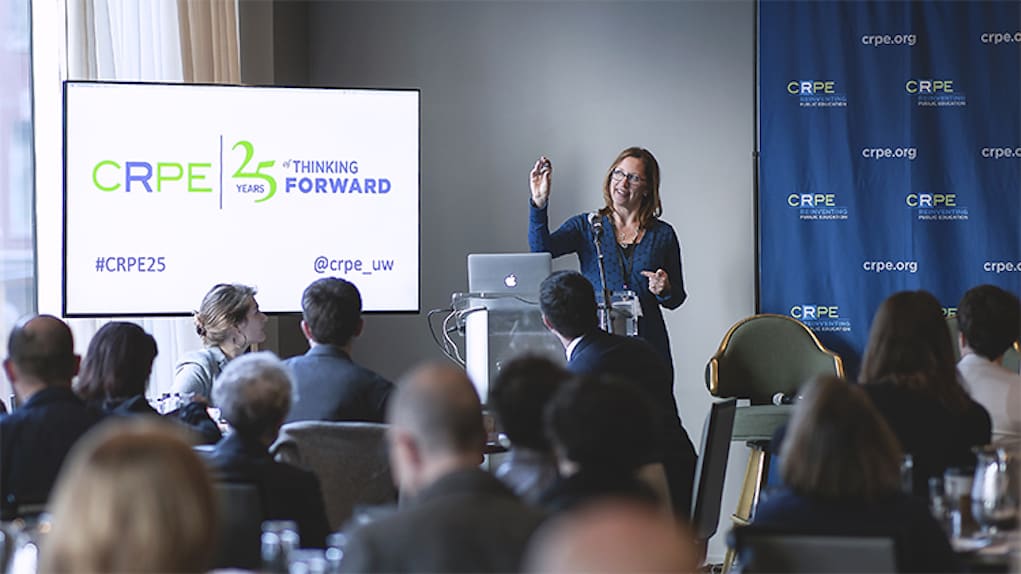The Year of Thinking Forward

By: Robin Lake
In 2018 CRPE celebrated an important milestone, marking 25 years of ideas, evidence, and impact.
This year we look forward to translating our newest ideas into action. We’re working on a round of cutting-edge research projects exploring issues like special education, career pathways, and new efforts to customize learning. We’ll continue to help policymakers and practitioners implement our ideas in their work. We’re launching a “Big Think Network” dedicated to solving the next generation of challenges facing public education.
We believe our best contribution has always been looking around the corner. Since our founding, much has improved in U.S. public education, but daunting challenges remain. Preparing the next generation for an uncertain future will require bold new ideas, not just tweaks to the old system.
We laid out some pretty provocative ideas in our recent 25th-anniversary essay collection, Thinking Forward: New Ideas for a New Era. Our essays call for a shift in mindset from a portfolio of schools to a portfolio of learning opportunities. This has big implications. If we are serious about serving not just all students, but every student, we have to consider how to create customized pathways that are not beholden to past assumptions about where and how education is delivered. In case you haven’t had a chance to read them yet, here’s our list of the most important ideas in our new collection:
Design for tails, not the mean. Students with complex learning needs are some of our most vulnerable, but also often America’s hidden talent. Students will graduate into an increasingly competitive global labor market, and they will confront complex societal problems. We need all the talent and unusual thinking we can find. How can we design schools and school systems that ensure every student can realize his or her untapped potential? We argue those designs would necessarily require more customized educational approaches and policies to enable them, and, therefore, designing for the most unusual students will ultimately benefit all.
Tie accountability to what students and their families know matters. We propose a novel approach to accountability that assumes a more customized learning system. Younger students would have outcome requirements focused only on a limited set of core gateway competencies, like early literacy and numeracy, and developmental skills directly linked to readiness for secondary education. Older students could select or build personalized learning pathways by earning competency-based credits toward high school graduation, college coursework, and industry credentials.
End high school as we know it. We question whether four years of high school followed by four years of college makes sense as the primary path to a better life. It is far too rigid and expensive a model to work for the future. We push for a total rethink of the traditional high school model and make clear that this cannot happen without challenging many entrenched policies and practices, from high school funding models to higher education credit systems. Students and their families should be able to choose not just schools but individual courses, allowing them to arrange their high school experiences to include more college classes or career prep opportunities. Students should not be held hostage to the offerings of a given school; rather, they should be allowed to opt out of electives and use that funding in more customized ways.
Rethink postsecondary education, too. College debt is crushing. Students lack opportunities to explore different post-secondary pathways as their skills and interests develop. At the same time, many students don’t have eight years to figure out what they want to do and what skills they will need. The types of jobs available and the skills required will change rapidly. To successfully prepare students for the future, we need a more permeable system. Students should have access to college-level coursework and credits as soon as they are ready. And they should be able to explore career pathways without fear that they’ll wind up in a “track” that carries an academic stigma or closes doors to them in the future. Schools and districts must flex to accommodate internships and apprenticeships. Employers should have more input into the types of competencies students require to be career ready.
Wrap social services around students, not schools. While many cities continue to make academic gains, students and their families must have improved access to community-based mental health and social services. Decades of efforts to bring “wraparound services” to schools have not yielded much progress. They typically have proven hard to coordinate and are usually not well integrated with learning goals. New programs are pushing the boundaries by flipping the model, using out-of-school time to aggressively package supports and experiences tailored to individual student needs. A more organic, crowdsourced approach to engaging the community could ultimately result in more agile and responsive opportunities for students—but only if key questions about measuring impact, creating coherent learning experiences, and ensuring equal access are addressed.
Make public education funding more flexible, and allow it to follow students longer. We believe the needs of the future demand, in many cases, more public funding. But they also require unlocking funds that are currently used unproductively. A student who graduates early could use saved funds for additional learning later in life. While still in school, a student developing a passion for dance could pay for specialized dance classes by forgoing another elective.
Innovate to ensure that all students benefit from the type of customization that only the most advantaged currently enjoy. What we propose isn’t entirely new. Today, families with means can ensure that their child’s unique needs are met, even if it means homeschooling, purchasing tutoring services, or organizing summer enrichment classes. So where others have explored the potential of an unbundled approach to education, we also recognize the risks for the least advantaged families. We propose that student-focused portfolio systems of the future must include strong information systems, “navigators” who help students and their families organize learning, and new roles for government to limit those risks and protect the public interest.
Some schools or CMOs might take the navigator role to another level, specializing in curating individualized learning experiences for students rather than delivering all (or any!) instruction themselves. They might take a set-aside fee for helping families develop an individualized learning plan and access a customized mix of core curriculum, advanced learning, tutoring, therapeutic services, international exchange opportunities, out-of-school enrichment, and career preparation. An increasing number of organizations are innovating in these ways. But we need many more.
Oversee portfolios of diverse learning opportunities, not just schools. CRPE’s founding idea was that the role of government has to shift away from one-size-fits-all delivery models and toward oversight of a system of diverse options for families. While we originally imagined those options to be schools, we now see that school boards, charter authorizers, and states must broaden their attention to support multiple pathways. Government should focus on ensuring there is a strong supply of not only schools, but a wide range of industry, community, and service partnerships and providers to meet every student’s needs.
Be willing to disrupt existing institutions and power structures. These proposals imply a set of policy changes and system adaptations that are hard to imagine today. Some require cooperative agreements and collaborations among higher education, school districts, industry, and community service providers—entities that have not played well together. They imply major shifts in how we train educators, and perhaps in their labor contracts. There are potentially many new costs implied throughout, despite many options for redistributing funding.
Allow students and families to craft their own solutions. Perhaps most important, we believe that the status quo, both in district and charter school systems, has proven too strong to shift on its own. Little of what we propose can happen without empowering families—especially those without the advantages of time, money, and political power—to organize learning in new ways, and to opt out of set packages of schooling so that every student can develop their unique talents.
More than two decades ago, Reinventing Public Education mapped a vision for the future where districts might not run all of their schools, but instead oversee performance. The book argued that, while parents must be free to choose and educators must be free to teach, educational opportunities must remain publicly governed and accessible to all.
Thinking Forward imagines a future where school systems push those principles to a new level, creating more of the conditions for cities to realize students’ untapped potential and prepare them to solve the challenges of the future.
We’ve had many great responses to our essays, but the one I enjoyed the most was from a friend who runs a large school system. His reaction after reading was: “I feel like I need a drink.” He continued, “I think you guys are right. We have to shift toward the future, but I have no idea how we’re going to do it.”
We are committed to helping the education field shift toward the future. Let’s make 2019 the year of thinking forward.
For more, see:
This post was originally published on CRPE.org.
Robin Lake is director of the Center on Reinventing Public Education (CRPE) a non-partisan research and policy analysis organization developing transformative, evidence-based solutions for K–12 public education. Connect with her on Twitter at @RbnLake.
Stay in-the-know with innovations in learning by signing up for the weekly Smart Update.




0 Comments
Leave a Comment
Your email address will not be published. All fields are required.